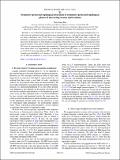Symmetry-protected topological invariants of symmetry-protected topological phases of interacting bosons and fermions
Author(s)
Wen, Xiao-Gang
DownloadWen-2014-Symmetry-protected topological.pdf (1.208Mb)
PUBLISHER_POLICY
Publisher Policy
Article is made available in accordance with the publisher's policy and may be subject to US copyright law. Please refer to the publisher's site for terms of use.
Terms of use
Metadata
Show full item recordAbstract
Recently, it was realized that quantum states of matter can be classified as long-range entangled states (i.e., with nontrivial topological order) and short-range entangled states (i.e., with trivial topological order). We can use group cohomology class H[superscript d](SG,R/Z) to systematically describe the SRE states with a symmetry SG [referred as symmetry-protected trivial (SPT) or symmetry-protected topological (SPT) states] in d-dimensional space-time. In this paper, we study the physical properties of those SPT states, such as the fractionalization of the quantum numbers of the global symmetry on some designed point defects and the appearance of fractionalized SPT states on some designed defect lines/membranes. Those physical properties are SPT invariants of the SPT states which allow us to experimentally or numerically detect those SPT states, i.e., to measure the elements in H[superscript d](G,R/Z) that label different SPT states. For example, 2+1-dimensional bosonic SPT states with Z[subscript n] symmetry are classified by a Z[subscript n] integer m ∈ H[superscript 3](Z[subscript n],R/Z) = Z[subscript n]. We find that n identical monodromy defects, in a Z[subscript n] SPT state labeled by m, carry a total Z[subscript n] charge 2m (which is not a multiple of n in general).
Date issued
2014-01Department
Massachusetts Institute of Technology. Department of PhysicsJournal
Physical Review B
Publisher
American Physical Society
Citation
Wen, Xiao-Gang. “Symmetry-Protected Topological Invariants of Symmetry-Protected Topological Phases of Interacting Bosons and Fermions.” Phys. Rev. B 89, no. 3 (January 2014). © 2014 American Physical Society
Version: Final published version
ISSN
1098-0121
1550-235X